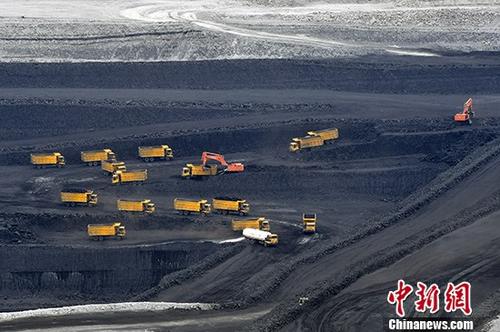(Economic Observation) China expands the floating space of coal-fired electricity prices to ensure stable electricity supply
China News Service, Beijing, October 12th, title: China expands the floating space of coal-fired electricity prices to ensure stable electricity supply
China News Agency reporter Zhou Rui
In the case of power curtailment and production restrictions in some areas, the National Development and Reform Commission of China launched on the 12th a reform of the market-oriented feed-in tariff for coal-fired power generation to straighten out the relationship between "coal power" and ensure the safe and stable supply of power.
At the same time, this reform emphasizes the need to maintain the stability of electricity prices for residents and agriculture.
People will not pay more electricity bills for this reason.
Data map: Located in the Zhundong Economic and Technological Development Zone in Xinjiang, in the south open-pit coal mine of Xinjiang Tianchi Energy Co., Ltd., large transportation vehicles are busy transferring raw coal in a pit about 200 meters deep.
Photo by China News Agency reporter Liu Xin
Ensuring a stable supply of electricity
The reason for the recent shortage of power supply in some places in China is that although there are factors such as low water leading to a year-on-year decline in hydroelectric power generation, and a sharp drop in wind power supply due to lack of wind, the main reason is that thermal power is "not enough."
The problem with thermal power is the price of coal.
For coal-fired power plants, coal prices have repeatedly hit record highs, causing their power generation costs to continue to rise.
On the other hand, due to restrictions on coal-fired power price fluctuations, its power generation revenue cannot increase simultaneously.
Previous media investigations found that some power plants chose to increase the number of units that were shut down for maintenance when the more power they generated, the more loss they were.
Therefore, to increase the power generation of thermal power, there are two urgent things: one is to increase the supply of coal.
The National Development and Reform Commission has previously clearly requested that all localities should make every effort to increase production and supply of coal, moderately increase coal imports, and effectively supplement domestic supply.
The second is to straighten out the problem of poor linkage between coal and electricity prices.
This is one of the important goals of this reform.
Wan Jinsong, director of the Price Department of the National Development and Reform Commission, said that the reform will expand the range of fluctuations in market transaction electricity prices.
Increase the fluctuation range of coal-fired power generation market transaction price from the current float not more than 10%, and in principle not more than 15%, to expand to not more than 20% in principle, and the market transaction price of high energy-consuming enterprises will not be increased by 20%. limit.
This means that coal-fired power plants will be able to cover the increase in costs through price fluctuations.
Ensure that people's electricity bills do not increase
Regarding the increase in electricity tariffs that the public is worried about, Wan Jinsong made it clear that during the reform process, electricity prices for residents, agriculture, and public welfare undertakings will be kept stable.
Residents (including schools, social welfare institutions, community service centers and other public welfare users that implement residential electricity prices), agricultural electricity supply is guaranteed by grid companies, and the current sales electricity price level remains unchanged.
Peng Shaozong, deputy director of the Price Department of the National Development and Reform Commission, also emphasized that the reform, with special emphasis on maintaining the stability of residential and agricultural electricity prices, has no direct impact on the consumer price index (CPI).
However, Peng Shaozong said frankly that if the market transaction electricity price rises, it will push up the electricity cost of enterprises, especially upstream production enterprises, to a certain extent, and will have a certain boosting effect on the industrial producer price index (PPI).
However, he also emphasized that the reform measures are conducive to improving the power supply and demand situation, better ensuring the power demand of enterprises, promoting stable production of enterprises, increasing market supply, and generally conducive to price stability.
On the whole, the impact of this reform on price levels is limited.
Power market reform has taken a big step
Although in the short term, the reform will bring about an increase in market transaction electricity prices.
But the purpose of the reform is not to increase prices, but to promote the marketization of electricity.
From the perspective of power generation, only about 70% of China’s coal-fired power generation has formed a feed-in tariff through participation in the power market.
The reform clearly promoted the remaining 30% of coal-fired power generation to enter the electricity market.
Wan Jinsong believes that this will further drive other types of power generation electricity into the market and lay a solid foundation for the full development of power-side feed-in tariffs.
From the perspective of electricity consumption, about 44% of China's industrial and commercial electricity consumption has formed electricity prices through participation in the market.
The reform clearly proposes to promote the orderly promotion of industrial and commercial users to enter the electricity market and purchase electricity at market prices.
Wan Jinsong emphasized that this reform represents another important step in China's power market reform, and it has truly established a market-based electricity price mechanism that "can fall but rise".
(over)

